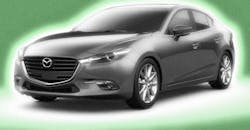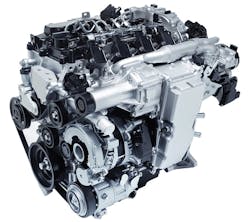More electricity is being generated using renewable, clean energy sources like solar and wind, but the bulk is still generated using fossil fuel. Electric vehicles can only be as efficient as their power source. One reason fixed fossil fuel power plants can beat fossil fuel car engines is efficiency. This is why Mazda’s Skyactive-X engine (see photo) can challenge electric vehicles.
The Skyactive-X engine looks to push thermal efficiency to 56%. This is a 27% increase over existing engines, and is achieved using two key features. The first is a heterogeneous combustion mixture, as opposed to a more conventional homogeneous charge compression ignition (HCCI). The second is the use of a spark plug in what is essentially a diesel engine, which would not normally use one. The spark-controlled compression ignition (SpCCI) system essentially fires up the explosion before the piston head reaches its peak in the cycle.
Mazda’s Skyactive-X engine is pushing 56% thermal efficiency, which could challenge electric vehicles.
The system essentially uses a richer mixture, the spark plug, that in turns ignites the remaining leaner mixture. The timed explosion has other benefits. The pressure rise is more gradual, allowing the use of an engine block that has less reinforcement around the cylinder than a conventional system. It also reduces the pinging noise normally associated with a diesel engine.
Generating the rich/lean mixture takes a Root-type compressor that drives only half of the intakes. This swirls the mixture so the richer portion is near the spark plug. The pressure is also designed to be between the usual gas and diesel pressures, about 8,000 psi, to reduce soot formation.
The engine’s emissions are one par with the earlier Skyactiv-G. This means that there is no need for a lean-NoX catalyst.
Mazda estimates that the 2.0 liter Skyactiv-X will be on par with the 2.2 liter Skyactiv-G. There is also an expected 10 to 30% torque boost.
About the Author
William G. Wong
Senior Content Director - Electronic Design and Microwaves & RF
I am Editor of Electronic Design focusing on embedded, software, and systems. As Senior Content Director, I also manage Microwaves & RF and I work with a great team of editors to provide engineers, programmers, developers and technical managers with interesting and useful articles and videos on a regular basis. Check out our free newsletters to see the latest content.
You can send press releases for new products for possible coverage on the website. I am also interested in receiving contributed articles for publishing on our website. Use our template and send to me along with a signed release form.
Check out my blog, AltEmbedded on Electronic Design, as well as his latest articles on this site that are listed below.
You can visit my social media via these links:
- AltEmbedded on Electronic Design
- Bill Wong on Facebook
- @AltEmbedded on Twitter
- Bill Wong on LinkedIn
I earned a Bachelor of Electrical Engineering at the Georgia Institute of Technology and a Masters in Computer Science from Rutgers University. I still do a bit of programming using everything from C and C++ to Rust and Ada/SPARK. I do a bit of PHP programming for Drupal websites. I have posted a few Drupal modules.
I still get a hand on software and electronic hardware. Some of this can be found on our Kit Close-Up video series. You can also see me on many of our TechXchange Talk videos. I am interested in a range of projects from robotics to artificial intelligence.



